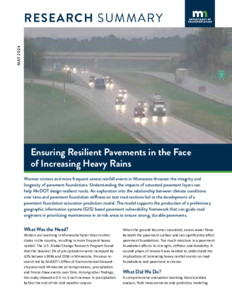MnDOT Flash Flood Vulnerability and Adaptation Assessment Pilot Project
Creator
Date Created
2014-11
Description
Development of Mix Designs and Matrix of Materials for MnROAD Low Carbon Concrete Test Site
Date Created
2024-03
Report Number
NRRA202401
Description
Effect of Increased Precipitation (Heavy Rain Events) on Minnesota Pavement Foundations
Date Created
2024-04
Report Number
2024-08
Description
Climate Change Adaptation of Urban Stormwater Infrastructure
Creator
Date Created
2023-06
Report Number
2023-21
Description










